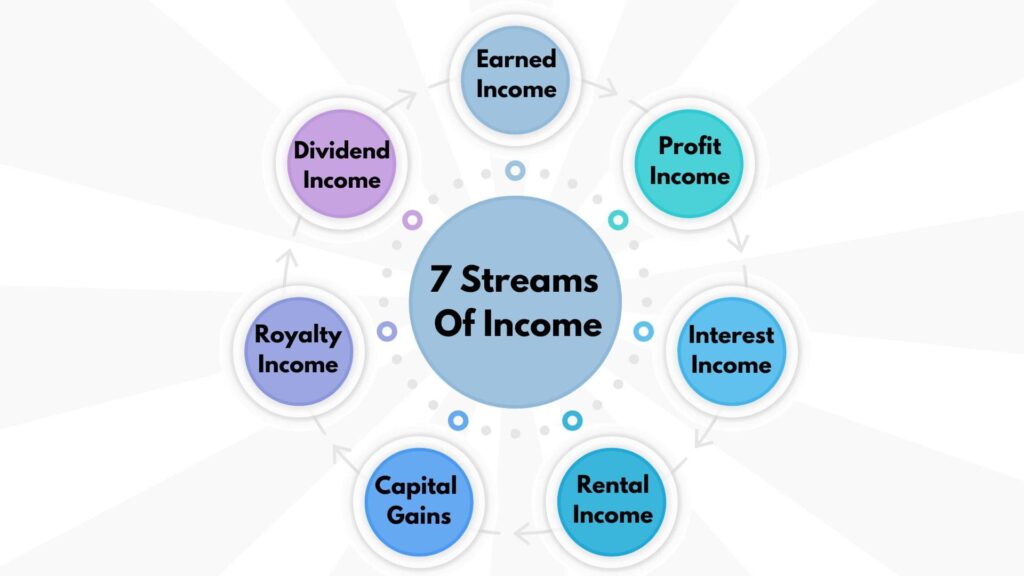
Sammie Ellard-King
I’m Sammie, a money expert and business owner passionate about helping you take control of your wallet. My mission with Up the Gains is to create a safe space to help improve your finances, cut your costs and make you feel good while doing it.
It is known that the average millionaire has 7 streams of income, which helps make them wealthy. These include active and passive streams of income.
Active income is money you generate from working for someone or directly from yourself. While passive is income, you receive continuously after completing the work or by investing and receiving profits from your investments.
If you want to become a millionaire, then increasing your income is the only real way you can get there within your lifetime.
In this article, we will be discussing what 7 streams of income you’ll need to master to make you a millionaire.
Table of Contents
What are the 7 streams of income?

Having 7 streams of income means that you have multiple sources of income, which can help you create financial stability and diversity.
By spreading your income across multiple areas, you reduce the risk of relying on a single income source and minimize the impact of any potential losses.
This also allows you to generate passive income, which means you can earn money without actively working, giving you more freedom and flexibility to pursue your passions and hobbies.
Ultimately, the goal of having 7 streams of income is to achieve financial freedom faster and enjoy a more comfortable and fulfilling life.
1. Earned Income
This is the primary income that you will be receiving from your main full-time job. Earned income is also referred to as your salary.
The money you get is based on an hourly rate, plus commissions and bonuses that you may receive.
This type of income all means the same whether you are employed by a business or company, or you are self-employed and working for yourself.
Usually, this type of income is subject to tax. Although, there are different thresholds to meet, and this will affect the amount of tax you will end up paying.
2. Profit Income
Profit income is earned by owning and operating a business. Unlike earned income, which is limited by the number of hours worked, profit income has the potential to be unlimited by leveraging the time, skills, and resources of others.
However, generating profit income requires significant investment and effort to develop a business plan, establish relationships with suppliers and customers, and manage day-to-day operations.
Small businesses must also manage legal compliance, financial management, and operational risks.
Despite these challenges, profit income can be rewarding by providing freedom, flexibility, and potential wealth.
It is important to carefully consider the risks and challenges associated with starting and running a business before pursuing profit income as a stream of income.
3. Interest Income

Everyone has a bank account. However, if you have a savings bank account, you can earn interest on the money in that account.
However, it is important to note that the interest rate has dropped significantly since 2020. Usually interest rates would match the level of inflation, however, they are much lower these days.
Although, your savings account will still continue to add interest to your money. The percentage of interest on a million varies. You can find your rate of interest, by looking at old bank statements or chatting to your bank.
Another way to make interest income is by loaning money to another individual or business. You will then slower accumulate interest income over time as the loan is paid back.
This does create higher risk if the loan defaults but if you have a trustworthy loanee then this could be a solid stream of income.
Interest can kick back a monthly income or it can be yearly depending on your provider or loan terms.
4. Rental Income
Rental income is earned by renting out property or other assets like equipment or vehicles. It is a popular form of passive income because it can generate consistent revenue with relatively little effort.
However, it does require some initial investment and ongoing maintenance to maintain the property or assets being rented.
The potential benefits of rental income include the ability to generate passive income, build equity in the property or asset being rented, and benefit from potential appreciation in the property’s value over time.
Additionally, rental income can provide a measure of financial stability as long as the property is rented out regularly.
However, rental income also carries certain risks, such as tenants who damage the property or do not pay rent on time.
Despite these risks, rental income remains an attractive option for those looking to generate passive income with relatively little effort.
5. Capital Gains
Capital gains refer to the increase in the value of an asset, such as stocks, bonds, or real estate, between the time it is acquired and the time it is sold.
When an asset is sold for more than its original purchase price, the difference is considered a capital gain. Capital gains can be generated through both long-term and short-term investments and can provide a significant source of income for investors.
The main advantage of capital gains is that they can be earned without any ongoing effort or work. Investors can simply buy and hold assets, waiting for them to appreciate in value over time before selling them for a profit.
However, capital gains also carry some risks, such as market volatility and changes in tax laws. Additionally, investors must be prepared to invest a significant amount of capital upfront in order to generate substantial capital gains over time.
Despite these risks, capital gains remain a popular form of income for those looking to generate passive income through investments.
6. Royalty Income
Royalty income is earned by granting others the right to use one’s intellectual property, such as books, music, patents, or trademarks.
This means that every time someone uses or reproduces your work, you receive a royalty payment. It’s like being paid for every time someone uses a recipe you created or sings a song you wrote.
One of the fun things about royalty income is that it can come from unexpected sources.
Maybe a popular TV show wants to use your song in their season finale, or a bestselling author wants to reference your work in their next novel.
It’s like winning the lottery, but instead of picking numbers, you’re just creating great content that people love.
However, creating valuable intellectual property can be challenging and time-consuming, and the income generated from royalty payments can vary widely.
Despite these challenges, royalty income can be a lucrative source of passive income for those who are able to create valuable intellectual property.
7. Dividend Income

If you have any shares or stocks that you have invested in, they may provide you with dividends payments dependant on when the company pays out.
Often with stock investments you’ll find they are paid quarterly but this can change and be paid yearly or even monthly in some rare cases.
Essentially a company is paying you back a portion of their profits but be aware that dividends can rise and fall depending on the company. The trick is to find a stable company that’s paying or slightly increasing their dividend payments every single year.
Another way to earn dividend income is through businesses that you own. You as a Director and/or board member can pay yourself a dividend as long as the other company Directors are on board with that.
This can have tax benefits as Dividend Tax is often a lot less if you do not meet the higher thresholds in that current tax year.
Benefits Of 7 Streams Of Income
Having multiple streams of income offers numerous benefits that can make your life easier and help you achieve financial freedom faster.
With 7 streams of income, you won’t be affected much if one stream is struggling to make money, as your income is spread across multiple areas.
This financial stability allows you to take more risks and pursue your dreams, such as starting your own business or working on a new hobby.
By having a constant flow of money coming in, you can budget longer-term and reduce your dependence on a single paycheck. This means you can work fewer hours in your full-time job and have more time to do the things you love.
Having 7 streams of income can also help you generate passive income, which means you can earn money without actively working.
This gives you more freedom and flexibility to pursue other activities. While not every type of income may work for you, you can choose the streams that are best suited to your goals and desires.
How to create 7 streams of income?
To create multiple income streams, a strategic approach often starts with your primary job. This earned income is the foundation, providing financial stability and capital for further investments.
As you solidify this base, you can explore a side hustle or small business aligned with your skills or passions. This not only diversifies your income but can also offer personal fulfilment.
With the additional income from your side venture, you’re in a better position to delve into investment opportunities.
Investing in stocks, particularly those paying dividends, and bonds can gradually build your portfolio, adding layers of interest and dividend income.
Once these income sources are established and you’ve accumulated more capital, expanding into real estate could be the next step.
Rental income adds a valuable passive income stream and can significantly boost your financial portfolio.
Throughout this journey, always seek opportunities for learning and growth. Tailoring your approach to your unique skills, interests, and financial goals is key to successfully creating and managing multiple income streams.
Remember, the journey to building wealth through diverse income streams is progressive and often requires patience and persistence.
How many streams of income does the average millionaire have?
When examining the financial habits of average millionaires, it’s evident that relying on a single income source is rare.
Instead, they typically cultivate multiple streams of income to build and sustain their wealth. Research and studies, including those by authors like Thomas J. Stanley in “The Millionaire Next Door,” often highlight that millionaires usually have around three to seven different income streams.
This diversification strategy is not just about increasing wealth, but also about mitigating risks.
By spreading their investments across various areas such as businesses, stocks, real estate, and other ventures, millionaires are less vulnerable to financial setbacks in any one area.
This approach not only safeguards their wealth but also provides opportunities for continued growth and income generation.
Conclusion
Adopting the concept of 7 income streams is a pivotal strategy for achieving financial stability and expediting your path to financial independence.
Each stream serves as a fundamental pillar in constructing a robust financial structure, lessening your reliance on any single income source. This approach to diversification safeguards against economic uncertainties and facilitates the accumulation of wealth.
Embarking on this journey to incorporate these 7 types of income into your financial plan requires a strategy tailored to your unique skills, interests, and financial objectives.
Begin by strengthening your primary income and then gradually explore and integrate other areas such as side ventures, investments, and property.
The key is to start modestly, continually expand your knowledge, and judiciously broaden your sources of income.
Bear in mind, the path to amassing wealth and joining those who have harnessed the 7 sources of income to become a millionaire is distinct for each individual. It’s about discovering the ideal mix of income streams that align with your personal financial goals.
With commitment, steadfast effort, and a strategic approach, you can establish a solid financial foundation, ensuring a future that is not only wealthier but also financially secure and liberating.
Share on social media
Disclaimer: Content on this page is for informational purposes and does not constitute financial advice. Always do your own research before making a financially related decision.


